Human-Fish Relationships: Roles, Impacts, and Future Projections
VerifiedAdded on 2023/06/09
|8
|2181
|432
Essay
AI Summary
This essay examines the historical and modern interactions between humans and fish, highlighting their intertwined roles and relationships. Tracing human lineage back to fish, the essay explores the economic, environmental, and social importance of fish in human life. It discusses the evolution of fishing from aboriginal techniques to industrial-scale operations, impacting fish stocks and water resources. The essay also delves into fish intelligence and sentience, challenging common misconceptions. Furthermore, it addresses the impact of human activities on fish populations and the potential consequences for human health through consumption and other interactions. The conclusion speculates on future changes in human-fish interactions, driven by technological advancements and increased awareness of aquatic life, potentially leading to more harmonious relationships. Desklib offers a wealth of resources, including past papers and solved assignments, to aid students in their studies.
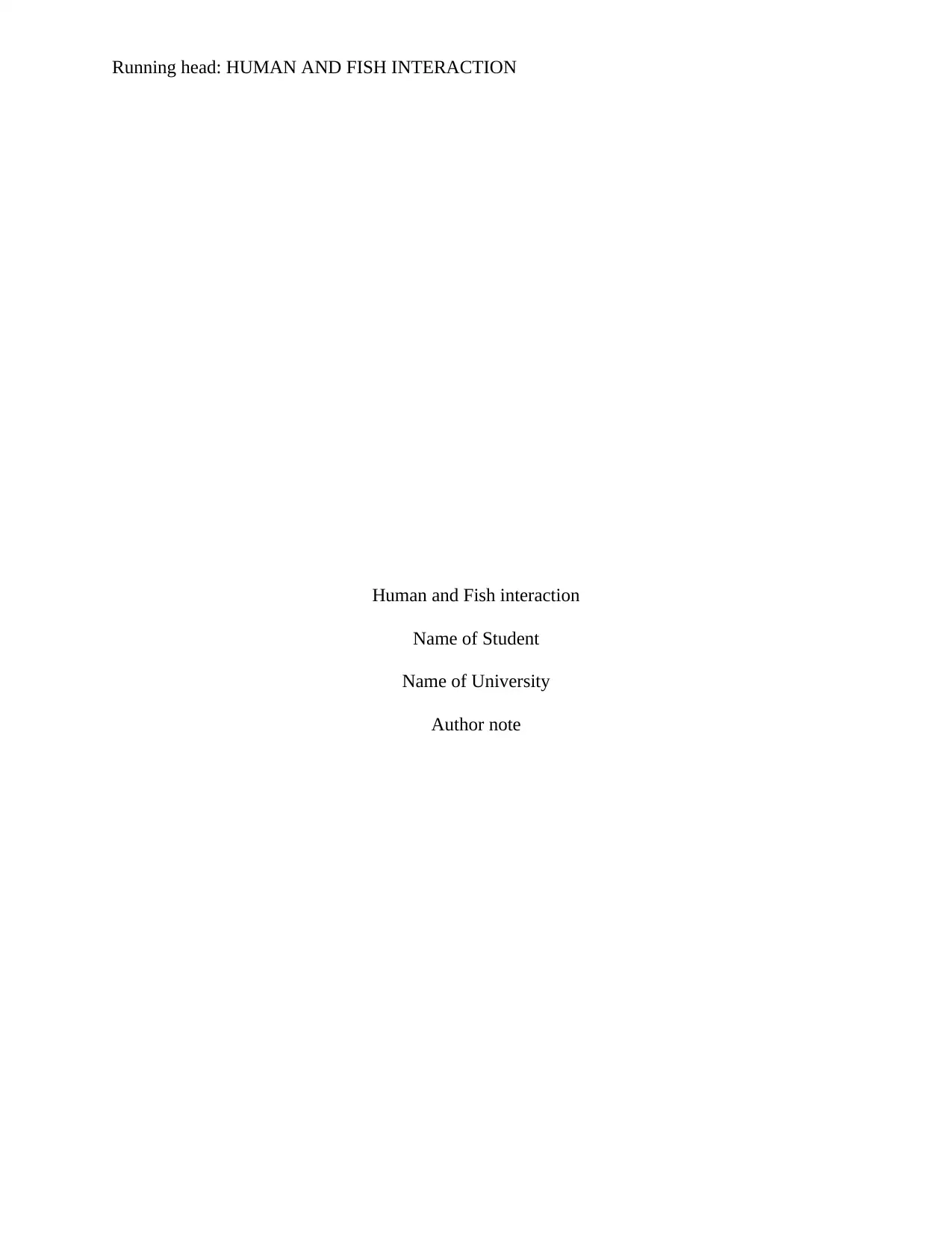
Running head: HUMAN AND FISH INTERACTION
Human and Fish interaction
Name of Student
Name of University
Author note
Human and Fish interaction
Name of Student
Name of University
Author note
Paraphrase This Document
Need a fresh take? Get an instant paraphrase of this document with our AI Paraphraser
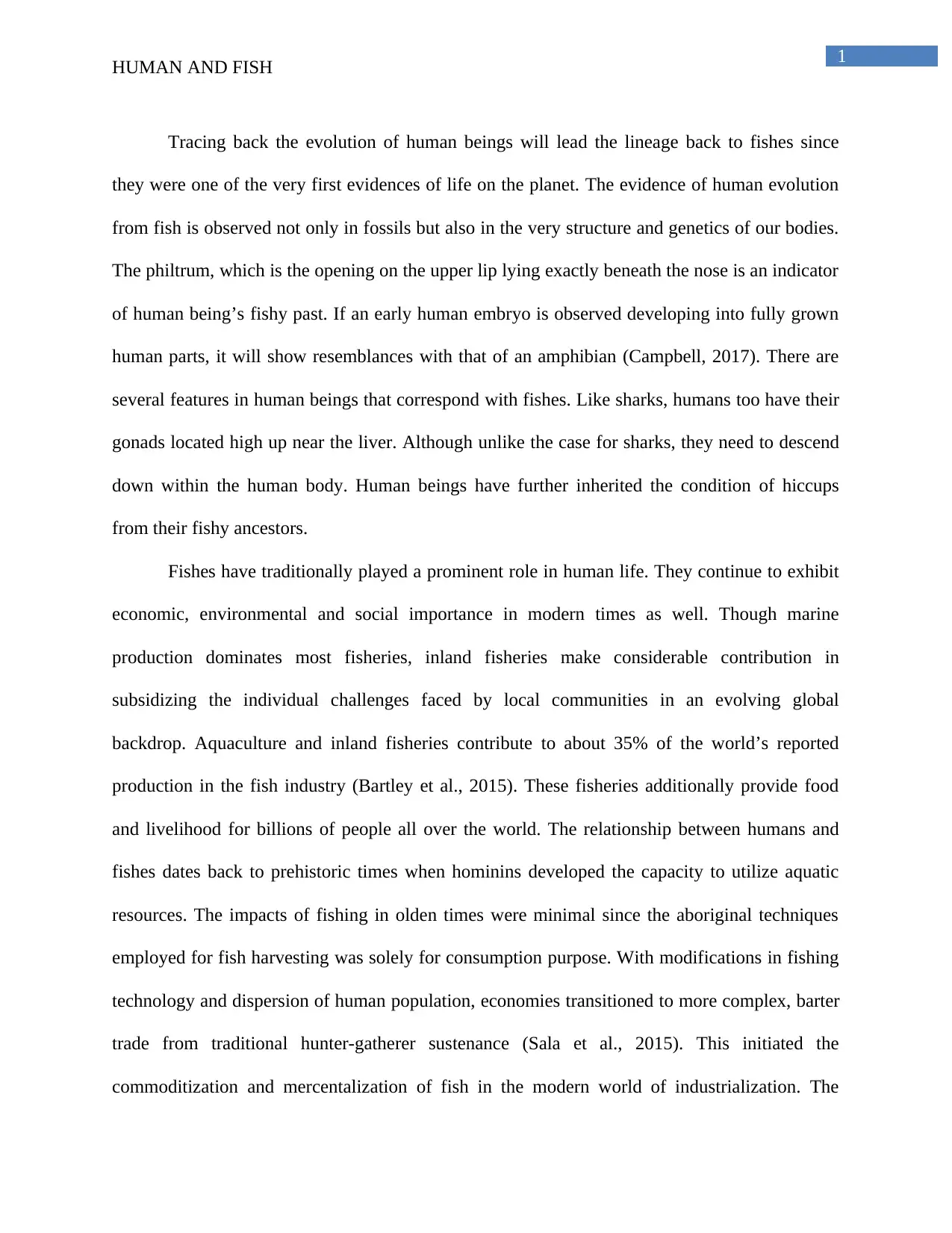
1
HUMAN AND FISH
Tracing back the evolution of human beings will lead the lineage back to fishes since
they were one of the very first evidences of life on the planet. The evidence of human evolution
from fish is observed not only in fossils but also in the very structure and genetics of our bodies.
The philtrum, which is the opening on the upper lip lying exactly beneath the nose is an indicator
of human being’s fishy past. If an early human embryo is observed developing into fully grown
human parts, it will show resemblances with that of an amphibian (Campbell, 2017). There are
several features in human beings that correspond with fishes. Like sharks, humans too have their
gonads located high up near the liver. Although unlike the case for sharks, they need to descend
down within the human body. Human beings have further inherited the condition of hiccups
from their fishy ancestors.
Fishes have traditionally played a prominent role in human life. They continue to exhibit
economic, environmental and social importance in modern times as well. Though marine
production dominates most fisheries, inland fisheries make considerable contribution in
subsidizing the individual challenges faced by local communities in an evolving global
backdrop. Aquaculture and inland fisheries contribute to about 35% of the world’s reported
production in the fish industry (Bartley et al., 2015). These fisheries additionally provide food
and livelihood for billions of people all over the world. The relationship between humans and
fishes dates back to prehistoric times when hominins developed the capacity to utilize aquatic
resources. The impacts of fishing in olden times were minimal since the aboriginal techniques
employed for fish harvesting was solely for consumption purpose. With modifications in fishing
technology and dispersion of human population, economies transitioned to more complex, barter
trade from traditional hunter-gatherer sustenance (Sala et al., 2015). This initiated the
commoditization and mercentalization of fish in the modern world of industrialization. The
HUMAN AND FISH
Tracing back the evolution of human beings will lead the lineage back to fishes since
they were one of the very first evidences of life on the planet. The evidence of human evolution
from fish is observed not only in fossils but also in the very structure and genetics of our bodies.
The philtrum, which is the opening on the upper lip lying exactly beneath the nose is an indicator
of human being’s fishy past. If an early human embryo is observed developing into fully grown
human parts, it will show resemblances with that of an amphibian (Campbell, 2017). There are
several features in human beings that correspond with fishes. Like sharks, humans too have their
gonads located high up near the liver. Although unlike the case for sharks, they need to descend
down within the human body. Human beings have further inherited the condition of hiccups
from their fishy ancestors.
Fishes have traditionally played a prominent role in human life. They continue to exhibit
economic, environmental and social importance in modern times as well. Though marine
production dominates most fisheries, inland fisheries make considerable contribution in
subsidizing the individual challenges faced by local communities in an evolving global
backdrop. Aquaculture and inland fisheries contribute to about 35% of the world’s reported
production in the fish industry (Bartley et al., 2015). These fisheries additionally provide food
and livelihood for billions of people all over the world. The relationship between humans and
fishes dates back to prehistoric times when hominins developed the capacity to utilize aquatic
resources. The impacts of fishing in olden times were minimal since the aboriginal techniques
employed for fish harvesting was solely for consumption purpose. With modifications in fishing
technology and dispersion of human population, economies transitioned to more complex, barter
trade from traditional hunter-gatherer sustenance (Sala et al., 2015). This initiated the
commoditization and mercentalization of fish in the modern world of industrialization. The
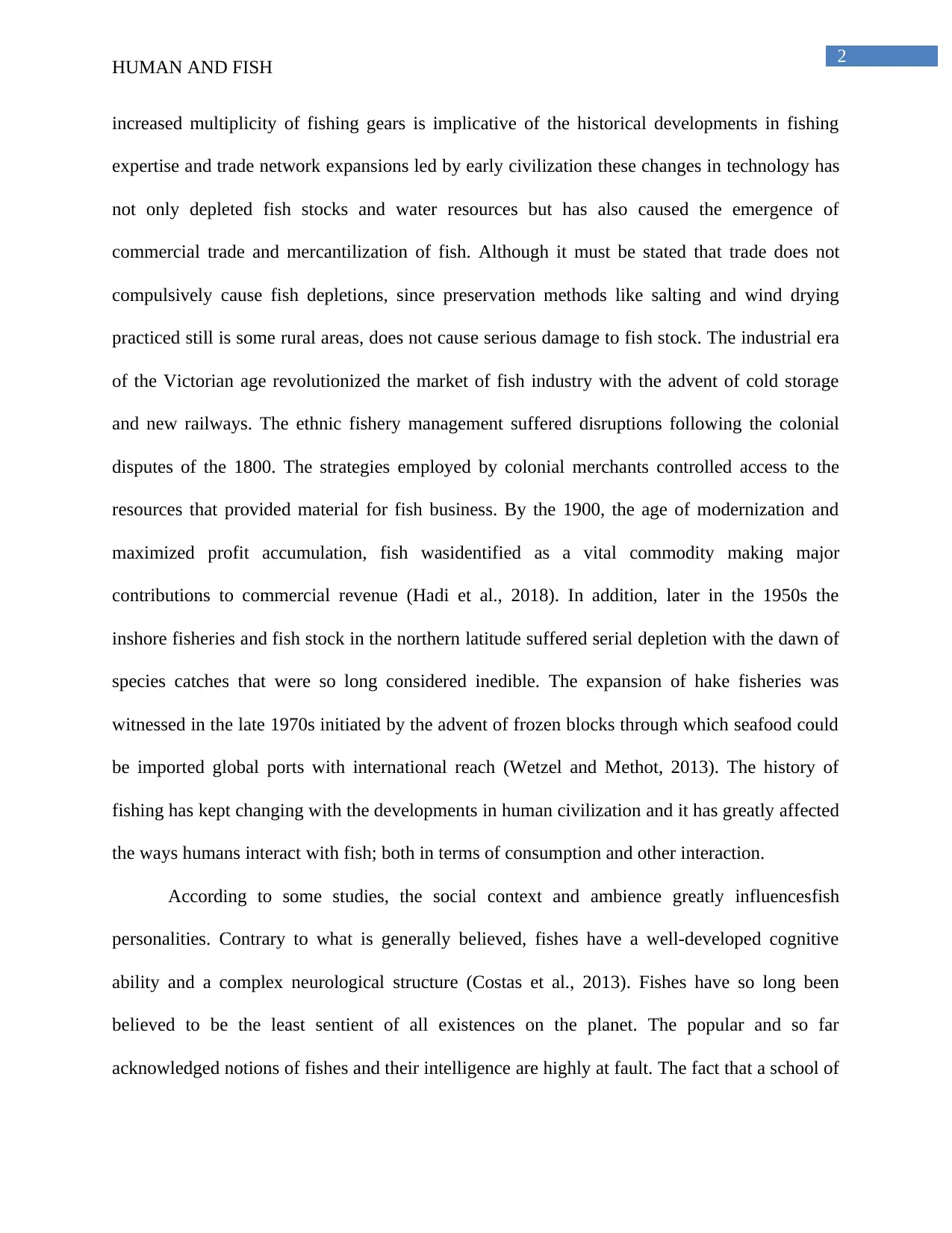
2
HUMAN AND FISH
increased multiplicity of fishing gears is implicative of the historical developments in fishing
expertise and trade network expansions led by early civilization these changes in technology has
not only depleted fish stocks and water resources but has also caused the emergence of
commercial trade and mercantilization of fish. Although it must be stated that trade does not
compulsively cause fish depletions, since preservation methods like salting and wind drying
practiced still is some rural areas, does not cause serious damage to fish stock. The industrial era
of the Victorian age revolutionized the market of fish industry with the advent of cold storage
and new railways. The ethnic fishery management suffered disruptions following the colonial
disputes of the 1800. The strategies employed by colonial merchants controlled access to the
resources that provided material for fish business. By the 1900, the age of modernization and
maximized profit accumulation, fish wasidentified as a vital commodity making major
contributions to commercial revenue (Hadi et al., 2018). In addition, later in the 1950s the
inshore fisheries and fish stock in the northern latitude suffered serial depletion with the dawn of
species catches that were so long considered inedible. The expansion of hake fisheries was
witnessed in the late 1970s initiated by the advent of frozen blocks through which seafood could
be imported global ports with international reach (Wetzel and Methot, 2013). The history of
fishing has kept changing with the developments in human civilization and it has greatly affected
the ways humans interact with fish; both in terms of consumption and other interaction.
According to some studies, the social context and ambience greatly influencesfish
personalities. Contrary to what is generally believed, fishes have a well-developed cognitive
ability and a complex neurological structure (Costas et al., 2013). Fishes have so long been
believed to be the least sentient of all existences on the planet. The popular and so far
acknowledged notions of fishes and their intelligence are highly at fault. The fact that a school of
HUMAN AND FISH
increased multiplicity of fishing gears is implicative of the historical developments in fishing
expertise and trade network expansions led by early civilization these changes in technology has
not only depleted fish stocks and water resources but has also caused the emergence of
commercial trade and mercantilization of fish. Although it must be stated that trade does not
compulsively cause fish depletions, since preservation methods like salting and wind drying
practiced still is some rural areas, does not cause serious damage to fish stock. The industrial era
of the Victorian age revolutionized the market of fish industry with the advent of cold storage
and new railways. The ethnic fishery management suffered disruptions following the colonial
disputes of the 1800. The strategies employed by colonial merchants controlled access to the
resources that provided material for fish business. By the 1900, the age of modernization and
maximized profit accumulation, fish wasidentified as a vital commodity making major
contributions to commercial revenue (Hadi et al., 2018). In addition, later in the 1950s the
inshore fisheries and fish stock in the northern latitude suffered serial depletion with the dawn of
species catches that were so long considered inedible. The expansion of hake fisheries was
witnessed in the late 1970s initiated by the advent of frozen blocks through which seafood could
be imported global ports with international reach (Wetzel and Methot, 2013). The history of
fishing has kept changing with the developments in human civilization and it has greatly affected
the ways humans interact with fish; both in terms of consumption and other interaction.
According to some studies, the social context and ambience greatly influencesfish
personalities. Contrary to what is generally believed, fishes have a well-developed cognitive
ability and a complex neurological structure (Costas et al., 2013). Fishes have so long been
believed to be the least sentient of all existences on the planet. The popular and so far
acknowledged notions of fishes and their intelligence are highly at fault. The fact that a school of
⊘ This is a preview!⊘
Do you want full access?
Subscribe today to unlock all pages.

Trusted by 1+ million students worldwide
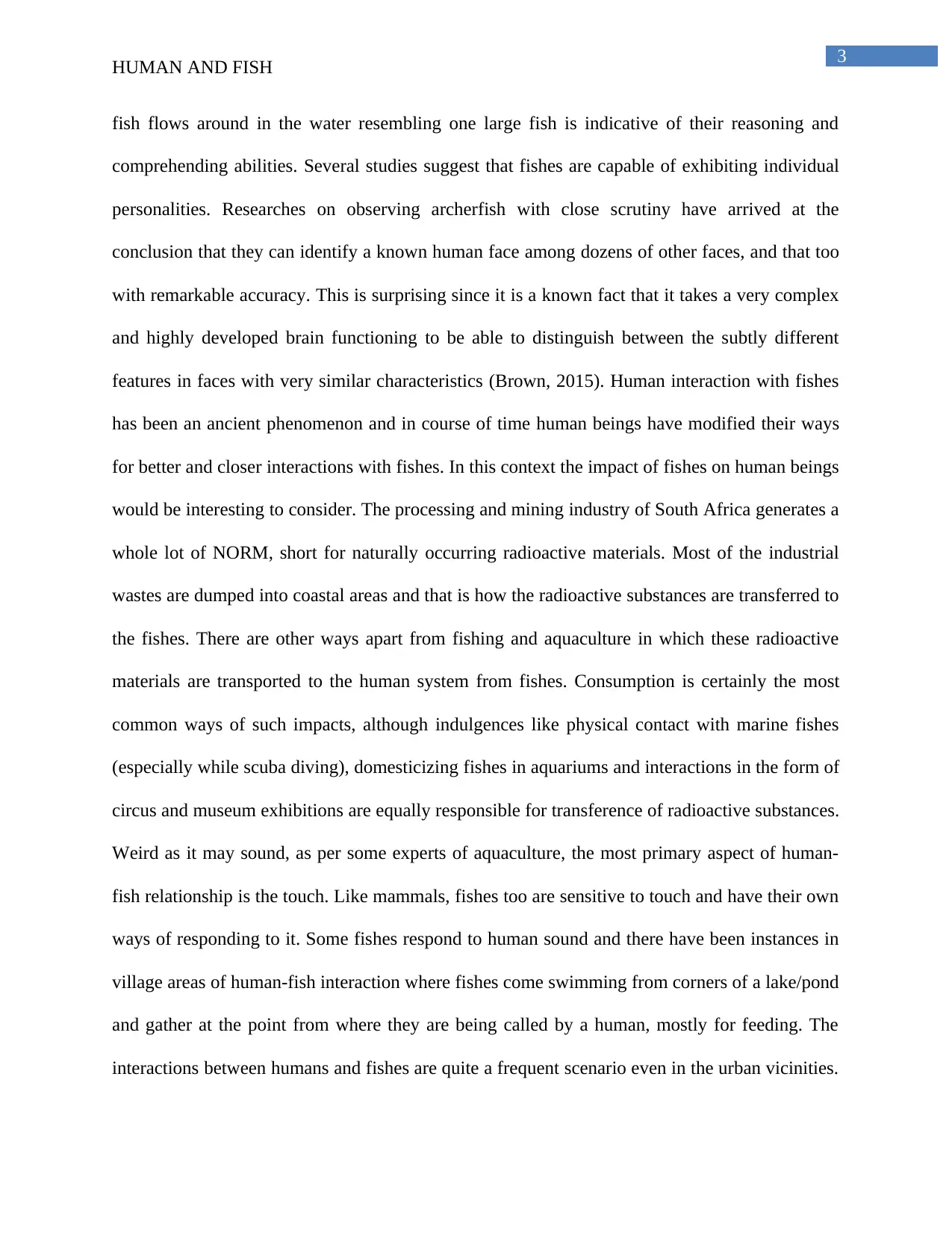
3
HUMAN AND FISH
fish flows around in the water resembling one large fish is indicative of their reasoning and
comprehending abilities. Several studies suggest that fishes are capable of exhibiting individual
personalities. Researches on observing archerfish with close scrutiny have arrived at the
conclusion that they can identify a known human face among dozens of other faces, and that too
with remarkable accuracy. This is surprising since it is a known fact that it takes a very complex
and highly developed brain functioning to be able to distinguish between the subtly different
features in faces with very similar characteristics (Brown, 2015). Human interaction with fishes
has been an ancient phenomenon and in course of time human beings have modified their ways
for better and closer interactions with fishes. In this context the impact of fishes on human beings
would be interesting to consider. The processing and mining industry of South Africa generates a
whole lot of NORM, short for naturally occurring radioactive materials. Most of the industrial
wastes are dumped into coastal areas and that is how the radioactive substances are transferred to
the fishes. There are other ways apart from fishing and aquaculture in which these radioactive
materials are transported to the human system from fishes. Consumption is certainly the most
common ways of such impacts, although indulgences like physical contact with marine fishes
(especially while scuba diving), domesticizing fishes in aquariums and interactions in the form of
circus and museum exhibitions are equally responsible for transference of radioactive substances.
Weird as it may sound, as per some experts of aquaculture, the most primary aspect of human-
fish relationship is the touch. Like mammals, fishes too are sensitive to touch and have their own
ways of responding to it. Some fishes respond to human sound and there have been instances in
village areas of human-fish interaction where fishes come swimming from corners of a lake/pond
and gather at the point from where they are being called by a human, mostly for feeding. The
interactions between humans and fishes are quite a frequent scenario even in the urban vicinities.
HUMAN AND FISH
fish flows around in the water resembling one large fish is indicative of their reasoning and
comprehending abilities. Several studies suggest that fishes are capable of exhibiting individual
personalities. Researches on observing archerfish with close scrutiny have arrived at the
conclusion that they can identify a known human face among dozens of other faces, and that too
with remarkable accuracy. This is surprising since it is a known fact that it takes a very complex
and highly developed brain functioning to be able to distinguish between the subtly different
features in faces with very similar characteristics (Brown, 2015). Human interaction with fishes
has been an ancient phenomenon and in course of time human beings have modified their ways
for better and closer interactions with fishes. In this context the impact of fishes on human beings
would be interesting to consider. The processing and mining industry of South Africa generates a
whole lot of NORM, short for naturally occurring radioactive materials. Most of the industrial
wastes are dumped into coastal areas and that is how the radioactive substances are transferred to
the fishes. There are other ways apart from fishing and aquaculture in which these radioactive
materials are transported to the human system from fishes. Consumption is certainly the most
common ways of such impacts, although indulgences like physical contact with marine fishes
(especially while scuba diving), domesticizing fishes in aquariums and interactions in the form of
circus and museum exhibitions are equally responsible for transference of radioactive substances.
Weird as it may sound, as per some experts of aquaculture, the most primary aspect of human-
fish relationship is the touch. Like mammals, fishes too are sensitive to touch and have their own
ways of responding to it. Some fishes respond to human sound and there have been instances in
village areas of human-fish interaction where fishes come swimming from corners of a lake/pond
and gather at the point from where they are being called by a human, mostly for feeding. The
interactions between humans and fishes are quite a frequent scenario even in the urban vicinities.
Paraphrase This Document
Need a fresh take? Get an instant paraphrase of this document with our AI Paraphraser
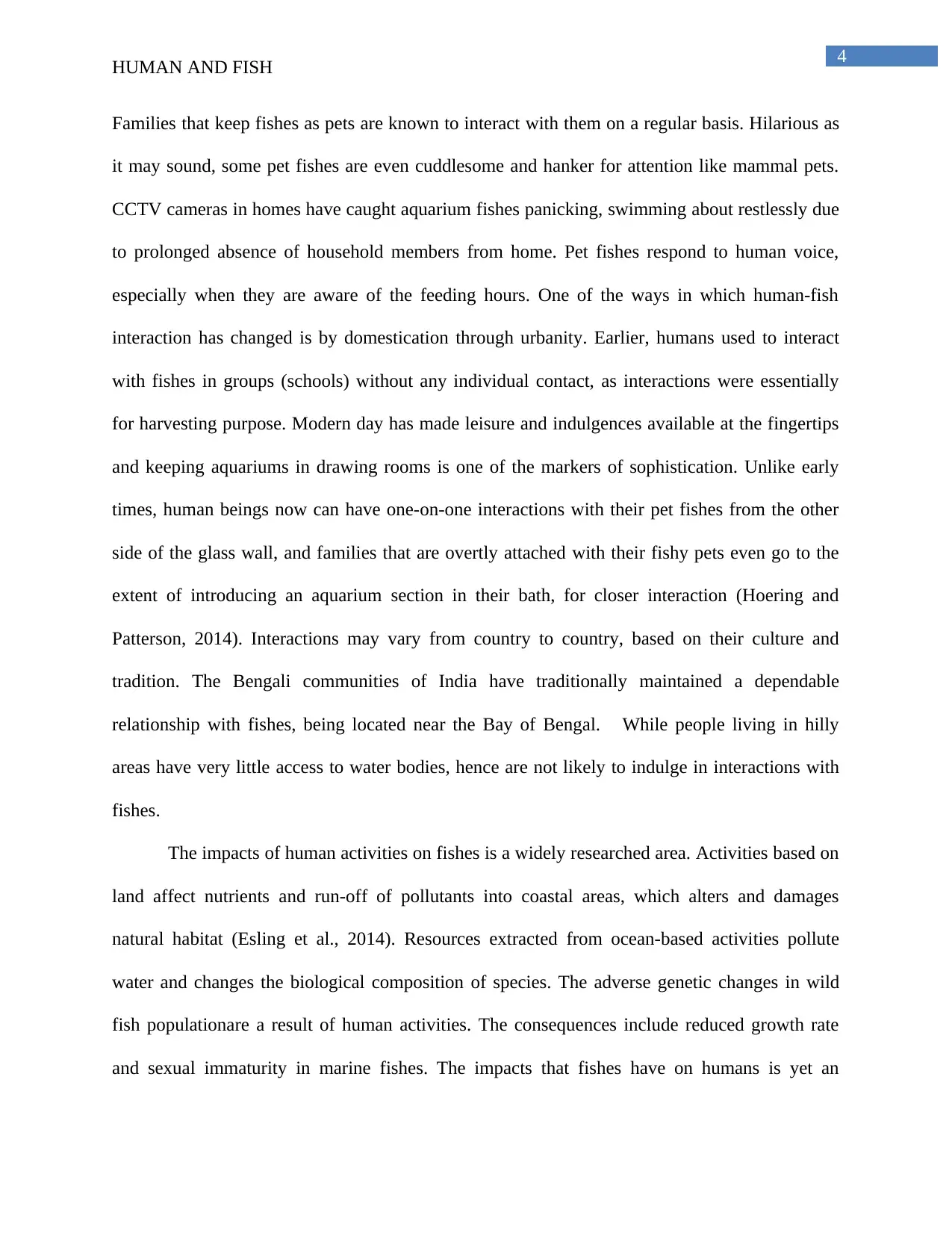
4
HUMAN AND FISH
Families that keep fishes as pets are known to interact with them on a regular basis. Hilarious as
it may sound, some pet fishes are even cuddlesome and hanker for attention like mammal pets.
CCTV cameras in homes have caught aquarium fishes panicking, swimming about restlessly due
to prolonged absence of household members from home. Pet fishes respond to human voice,
especially when they are aware of the feeding hours. One of the ways in which human-fish
interaction has changed is by domestication through urbanity. Earlier, humans used to interact
with fishes in groups (schools) without any individual contact, as interactions were essentially
for harvesting purpose. Modern day has made leisure and indulgences available at the fingertips
and keeping aquariums in drawing rooms is one of the markers of sophistication. Unlike early
times, human beings now can have one-on-one interactions with their pet fishes from the other
side of the glass wall, and families that are overtly attached with their fishy pets even go to the
extent of introducing an aquarium section in their bath, for closer interaction (Hoering and
Patterson, 2014). Interactions may vary from country to country, based on their culture and
tradition. The Bengali communities of India have traditionally maintained a dependable
relationship with fishes, being located near the Bay of Bengal. While people living in hilly
areas have very little access to water bodies, hence are not likely to indulge in interactions with
fishes.
The impacts of human activities on fishes is a widely researched area. Activities based on
land affect nutrients and run-off of pollutants into coastal areas, which alters and damages
natural habitat (Esling et al., 2014). Resources extracted from ocean-based activities pollute
water and changes the biological composition of species. The adverse genetic changes in wild
fish populationare a result of human activities. The consequences include reduced growth rate
and sexual immaturity in marine fishes. The impacts that fishes have on humans is yet an
HUMAN AND FISH
Families that keep fishes as pets are known to interact with them on a regular basis. Hilarious as
it may sound, some pet fishes are even cuddlesome and hanker for attention like mammal pets.
CCTV cameras in homes have caught aquarium fishes panicking, swimming about restlessly due
to prolonged absence of household members from home. Pet fishes respond to human voice,
especially when they are aware of the feeding hours. One of the ways in which human-fish
interaction has changed is by domestication through urbanity. Earlier, humans used to interact
with fishes in groups (schools) without any individual contact, as interactions were essentially
for harvesting purpose. Modern day has made leisure and indulgences available at the fingertips
and keeping aquariums in drawing rooms is one of the markers of sophistication. Unlike early
times, human beings now can have one-on-one interactions with their pet fishes from the other
side of the glass wall, and families that are overtly attached with their fishy pets even go to the
extent of introducing an aquarium section in their bath, for closer interaction (Hoering and
Patterson, 2014). Interactions may vary from country to country, based on their culture and
tradition. The Bengali communities of India have traditionally maintained a dependable
relationship with fishes, being located near the Bay of Bengal. While people living in hilly
areas have very little access to water bodies, hence are not likely to indulge in interactions with
fishes.
The impacts of human activities on fishes is a widely researched area. Activities based on
land affect nutrients and run-off of pollutants into coastal areas, which alters and damages
natural habitat (Esling et al., 2014). Resources extracted from ocean-based activities pollute
water and changes the biological composition of species. The adverse genetic changes in wild
fish populationare a result of human activities. The consequences include reduced growth rate
and sexual immaturity in marine fishes. The impacts that fishes have on humans is yet an
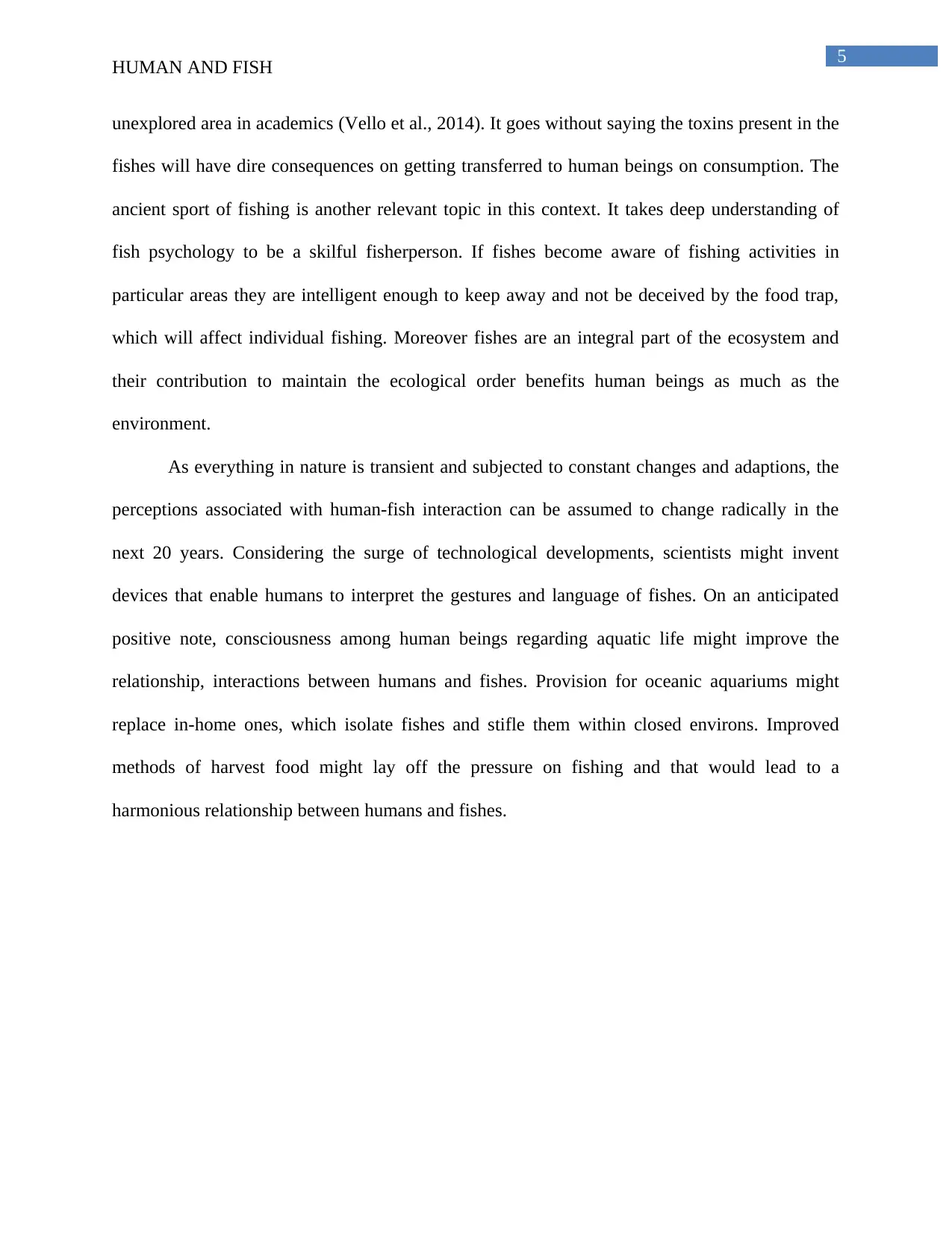
5
HUMAN AND FISH
unexplored area in academics (Vello et al., 2014). It goes without saying the toxins present in the
fishes will have dire consequences on getting transferred to human beings on consumption. The
ancient sport of fishing is another relevant topic in this context. It takes deep understanding of
fish psychology to be a skilful fisherperson. If fishes become aware of fishing activities in
particular areas they are intelligent enough to keep away and not be deceived by the food trap,
which will affect individual fishing. Moreover fishes are an integral part of the ecosystem and
their contribution to maintain the ecological order benefits human beings as much as the
environment.
As everything in nature is transient and subjected to constant changes and adaptions, the
perceptions associated with human-fish interaction can be assumed to change radically in the
next 20 years. Considering the surge of technological developments, scientists might invent
devices that enable humans to interpret the gestures and language of fishes. On an anticipated
positive note, consciousness among human beings regarding aquatic life might improve the
relationship, interactions between humans and fishes. Provision for oceanic aquariums might
replace in-home ones, which isolate fishes and stifle them within closed environs. Improved
methods of harvest food might lay off the pressure on fishing and that would lead to a
harmonious relationship between humans and fishes.
HUMAN AND FISH
unexplored area in academics (Vello et al., 2014). It goes without saying the toxins present in the
fishes will have dire consequences on getting transferred to human beings on consumption. The
ancient sport of fishing is another relevant topic in this context. It takes deep understanding of
fish psychology to be a skilful fisherperson. If fishes become aware of fishing activities in
particular areas they are intelligent enough to keep away and not be deceived by the food trap,
which will affect individual fishing. Moreover fishes are an integral part of the ecosystem and
their contribution to maintain the ecological order benefits human beings as much as the
environment.
As everything in nature is transient and subjected to constant changes and adaptions, the
perceptions associated with human-fish interaction can be assumed to change radically in the
next 20 years. Considering the surge of technological developments, scientists might invent
devices that enable humans to interpret the gestures and language of fishes. On an anticipated
positive note, consciousness among human beings regarding aquatic life might improve the
relationship, interactions between humans and fishes. Provision for oceanic aquariums might
replace in-home ones, which isolate fishes and stifle them within closed environs. Improved
methods of harvest food might lay off the pressure on fishing and that would lead to a
harmonious relationship between humans and fishes.
⊘ This is a preview!⊘
Do you want full access?
Subscribe today to unlock all pages.

Trusted by 1+ million students worldwide
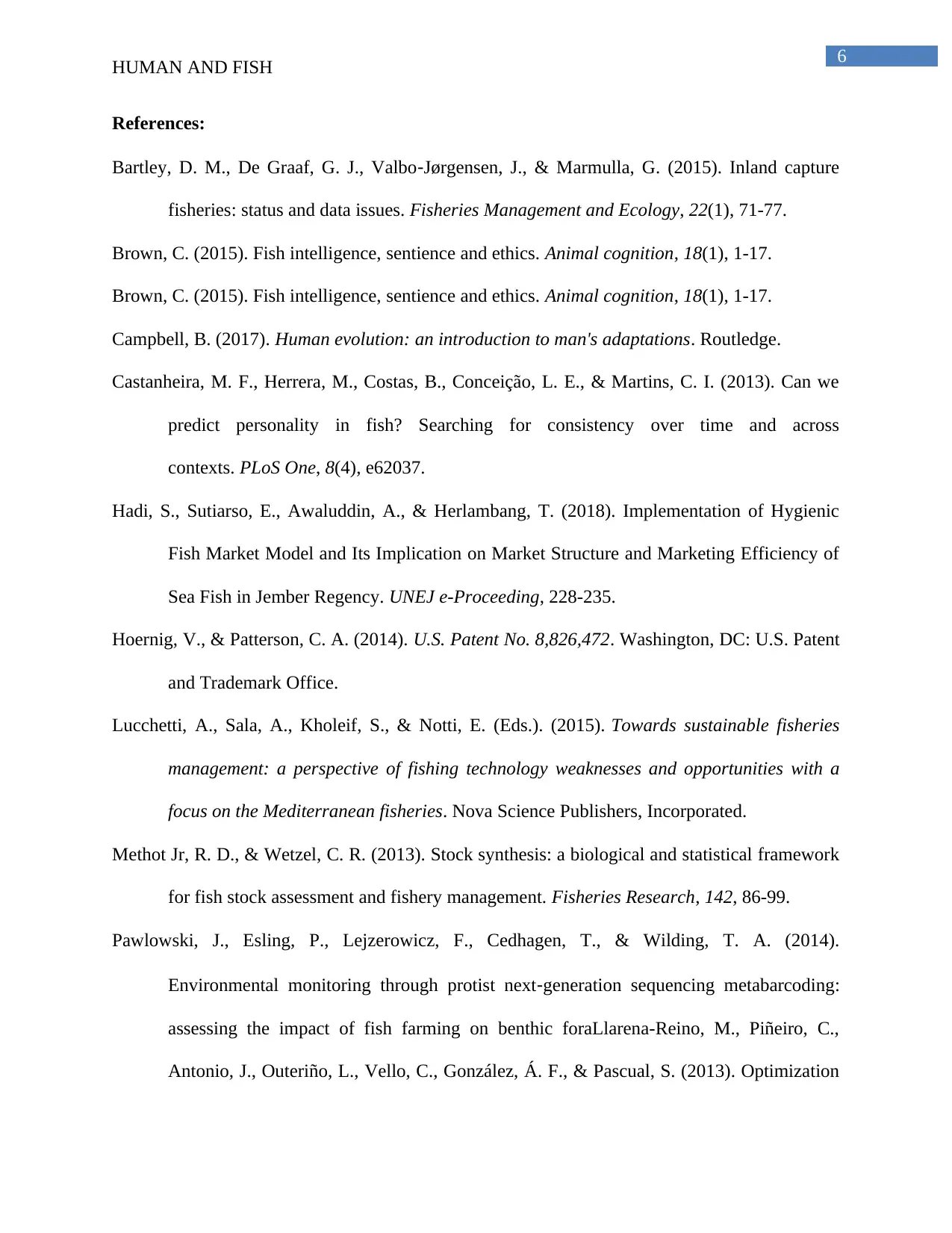
6
HUMAN AND FISH
References:
Bartley, D. M., De Graaf, G. J., Valbo‐Jørgensen, J., & Marmulla, G. (2015). Inland capture
fisheries: status and data issues. Fisheries Management and Ecology, 22(1), 71-77.
Brown, C. (2015). Fish intelligence, sentience and ethics. Animal cognition, 18(1), 1-17.
Brown, C. (2015). Fish intelligence, sentience and ethics. Animal cognition, 18(1), 1-17.
Campbell, B. (2017). Human evolution: an introduction to man's adaptations. Routledge.
Castanheira, M. F., Herrera, M., Costas, B., Conceição, L. E., & Martins, C. I. (2013). Can we
predict personality in fish? Searching for consistency over time and across
contexts. PLoS One, 8(4), e62037.
Hadi, S., Sutiarso, E., Awaluddin, A., & Herlambang, T. (2018). Implementation of Hygienic
Fish Market Model and Its Implication on Market Structure and Marketing Efficiency of
Sea Fish in Jember Regency. UNEJ e-Proceeding, 228-235.
Hoernig, V., & Patterson, C. A. (2014). U.S. Patent No. 8,826,472. Washington, DC: U.S. Patent
and Trademark Office.
Lucchetti, A., Sala, A., Kholeif, S., & Notti, E. (Eds.). (2015). Towards sustainable fisheries
management: a perspective of fishing technology weaknesses and opportunities with a
focus on the Mediterranean fisheries. Nova Science Publishers, Incorporated.
Methot Jr, R. D., & Wetzel, C. R. (2013). Stock synthesis: a biological and statistical framework
for fish stock assessment and fishery management. Fisheries Research, 142, 86-99.
Pawlowski, J., Esling, P., Lejzerowicz, F., Cedhagen, T., & Wilding, T. A. (2014).
Environmental monitoring through protist next‐generation sequencing metabarcoding:
assessing the impact of fish farming on benthic foraLlarena-Reino, M., Piñeiro, C.,
Antonio, J., Outeriño, L., Vello, C., González, Á. F., & Pascual, S. (2013). Optimization
HUMAN AND FISH
References:
Bartley, D. M., De Graaf, G. J., Valbo‐Jørgensen, J., & Marmulla, G. (2015). Inland capture
fisheries: status and data issues. Fisheries Management and Ecology, 22(1), 71-77.
Brown, C. (2015). Fish intelligence, sentience and ethics. Animal cognition, 18(1), 1-17.
Brown, C. (2015). Fish intelligence, sentience and ethics. Animal cognition, 18(1), 1-17.
Campbell, B. (2017). Human evolution: an introduction to man's adaptations. Routledge.
Castanheira, M. F., Herrera, M., Costas, B., Conceição, L. E., & Martins, C. I. (2013). Can we
predict personality in fish? Searching for consistency over time and across
contexts. PLoS One, 8(4), e62037.
Hadi, S., Sutiarso, E., Awaluddin, A., & Herlambang, T. (2018). Implementation of Hygienic
Fish Market Model and Its Implication on Market Structure and Marketing Efficiency of
Sea Fish in Jember Regency. UNEJ e-Proceeding, 228-235.
Hoernig, V., & Patterson, C. A. (2014). U.S. Patent No. 8,826,472. Washington, DC: U.S. Patent
and Trademark Office.
Lucchetti, A., Sala, A., Kholeif, S., & Notti, E. (Eds.). (2015). Towards sustainable fisheries
management: a perspective of fishing technology weaknesses and opportunities with a
focus on the Mediterranean fisheries. Nova Science Publishers, Incorporated.
Methot Jr, R. D., & Wetzel, C. R. (2013). Stock synthesis: a biological and statistical framework
for fish stock assessment and fishery management. Fisheries Research, 142, 86-99.
Pawlowski, J., Esling, P., Lejzerowicz, F., Cedhagen, T., & Wilding, T. A. (2014).
Environmental monitoring through protist next‐generation sequencing metabarcoding:
assessing the impact of fish farming on benthic foraLlarena-Reino, M., Piñeiro, C.,
Antonio, J., Outeriño, L., Vello, C., González, Á. F., & Pascual, S. (2013). Optimization
Paraphrase This Document
Need a fresh take? Get an instant paraphrase of this document with our AI Paraphraser

7
HUMAN AND FISH
of the pepsin digestion method for anisakids inspection in the fishing industry. Veterinary
parasitology, 191(3-4), 276-283.minifera communities. Molecular Ecology
Resources, 14(6), 1129-1140.
HUMAN AND FISH
of the pepsin digestion method for anisakids inspection in the fishing industry. Veterinary
parasitology, 191(3-4), 276-283.minifera communities. Molecular Ecology
Resources, 14(6), 1129-1140.
1 out of 8
Your All-in-One AI-Powered Toolkit for Academic Success.
+13062052269
info@desklib.com
Available 24*7 on WhatsApp / Email
![[object Object]](/_next/static/media/star-bottom.7253800d.svg)
Unlock your academic potential
Copyright © 2020–2025 A2Z Services. All Rights Reserved. Developed and managed by ZUCOL.
